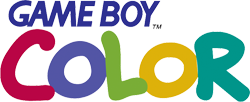From NintendoWiki, your source on Nintendo information. By fans, for fans.
Game Boy Color (GBC)
|
|
|
| No. of games
|
|
| No. of launch titles
|
{{{launch_games}}}
|
| Best-selling game
|
Pokémon Gold and Silver Versions (23.10 million copies)
|
| Last game
|
Doraemon no Study Boy Kanji Yomikaki Master (ドラえもんのスタディボーイ かんじよみかきマスター) (July 2003)
|
|
|
| Media
|
Game Boy and Game Boy Color cartridges
|
| Storage capacity
|
32 kbit (plus 128 kbit on cartridges)
|
| CPU
|
8-bit Z80, ran in single mode (4 MHz) and double mode (8 MHz)
|
| Model no.
|
{{{model}}}
|
|
| Can connect with
|
Nintendo GameCube
|
| Input
|
{{{input}}}
|
| Backwards compatible with
|
|
| Services provided
|
false
|
|
| Launch date
|
- NA - November 18, 1998
- JP - October 21, 1998
- EU - November 23, 1998
- AUS - November 23, 1998
|
| Discontinue date
|
2003
|
| Units sold
|
{{{sold}}}
|
|
|
|
The Game Boy Color was the first product in the second generation of Game Boy portable gaming systems, released by Nintendo in 1998. As the name implies, the Game Boy Color is capable of producing color graphics with a 32,768 color palette, at a rate of up to 56 simultaneous colors on-screen. The system's new infrared ports, located atop the console, allowed for communication between two Game Boy Colors at a distance of up to 2 meters; functions like Mystery Gift in Pokémon Gold and Silver fully utilized the Game Boy Color's infrared capability. The Game Boy Color greatly expanded the memory capacity of the portable console, up to twice that of the original Game Boy, and quadrupled the available processing power, comparable to the original Nintendo Entertainment System. Backwards compatibility to the game catalog of the original Game Boy, Game Boy Pocket, and Game Boy Light further increased the lifespan of the Game Boy Color. The system experienced a four year production run, and was officially taken out of production in 2002.
Specifications
- CPU: 8-bit Z80, ran in single mode (4 MHz) and double mode (8 MHz)
- RAM: 32 kbit (plus 128 kbit on cartridges)
- ROM: Cartridges up to 64 Mbit were made
- Video RAM: 16 kbit
- Sound: 4 Channel FM stereo
- Video: Highly reflective TFT LCD, 160x144 pixels made by Sharp
- Color Palette: 32,768 colors; Supports 10, 32, or 56 simultaneous colors on-screen
- Controls: 8 directional D-Pad, A, B, select, and start buttons.
- Communication: Serial or Infrared
- Serial: 512 kbit/s; up to 4 consoles at a time
- Infrared: Less than 2 meters at 45 degrees
- Power: 2 AA batteries provide ~13 hours. An AC Adapter (DC 3V) was also available.
See also

|
This article is a stub. You can help NintendoWiki by expanding it.
|
|
|
|
|
|
|
| Other
|
| Standalone consoles
|
Arcade
|
Pokémon
|
Classics
|
Cancelled
|
|
|
|
|
|
|
|



